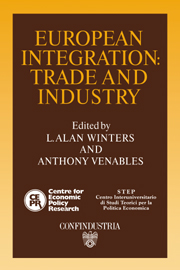Book contents
- Frontmatter
- Contents
- List of figures
- List of tables
- Preface
- Acknowledgements
- List of conference participants
- 1 European integration: trade and industry
- 2 Completing the internal market in the EC: factor demands and comparative advantage
- Discussion
- 3 External effects and Europe's integration
- Discussion
- 4 The quality and production of textiles and clothing and the completion of the internal market
- Discussion
- 5 Competition and imports in the European market
- Discussion
- 6 The structure and determinants of East–West trade: a preliminary analysis of the manufacturing sector
- Discussion
- 7 1992 and EFTA
- Discussion
- 8 Technology policy in the completed European market
- Discussion
- 9 Corporation tax, foreign direct investment and the single market
- Discussion
- 10 Japanese direct manufacturing investment in Europe
- Discussion
- Index
9 - Corporation tax, foreign direct investment and the single market
Published online by Cambridge University Press: 07 September 2010
- Frontmatter
- Contents
- List of figures
- List of tables
- Preface
- Acknowledgements
- List of conference participants
- 1 European integration: trade and industry
- 2 Completing the internal market in the EC: factor demands and comparative advantage
- Discussion
- 3 External effects and Europe's integration
- Discussion
- 4 The quality and production of textiles and clothing and the completion of the internal market
- Discussion
- 5 Competition and imports in the European market
- Discussion
- 6 The structure and determinants of East–West trade: a preliminary analysis of the manufacturing sector
- Discussion
- 7 1992 and EFTA
- Discussion
- 8 Technology policy in the completed European market
- Discussion
- 9 Corporation tax, foreign direct investment and the single market
- Discussion
- 10 Japanese direct manufacturing investment in Europe
- Discussion
- Index
Summary
Introduction
Corporation tax barely featured in the early discussion of the single market programme, receiving no more than passing mention in the 1985 White Paper on Completing the Internal Market. But as a perception grew that the advent of the single market could have significant effects on patterns of investment both within the Community and between the Community and the rest of the world, so too did a perception that something would have to be done about corporation tax. The European Commission has indeed now begun to press its view that ‘if Member states want to create a real internal market in which all Community enterprises can compete on an equal footing and which will bring about a more rational allocation of resources, they cannot escape the need to set up a common policy in the field of enterprise taxation’. At the time of writing, three main sets of proposals are under discussion. First, the Commission has revived its 1975 proposal for common adoption of the partial imputation method, the distinguishing feature of which is that part of the tax paid on corporate profits is credited against shareholders' liability to personal taxation on their dividend receipts. In fact, all but five Member States now operate some variant of imputation, though often failing to extend the credit to residents of other Member States in the even-handed way envisaged by the Commission.
- Type
- Chapter
- Information
- European IntegrationTrade and Industry, pp. 165 - 198Publisher: Cambridge University PressPrint publication year: 1991
- 3
- Cited by



